
KTM is an Austrian motorcycle, bicycle and motorsports brand which is co-owned by Indian manufacturer Bajaj Auto and Austrian manufacturer Pierer Mobility AG. It traces its foundation in 1934 as Kronreif & Trunkenpolz Mattighofen. Today, Pierer Mobility AG operates as the manufacturer of KTM branded motorcycles; whereas KTM Fahrrad AG operates as the manufacturer of KTM branded bicycles.

A. J. Stevens & Co. Ltd was a British automobile and motorcycle manufacturer in operation from 1909 to 1931. The company was founded by Joe Stevens in Wolverhampton, England. After the firm was sold, the name continued to be used by Matchless, Associated Motorcycles and Norton-Villiers on four-stroke motorcycles until 1969, and since the name's resale in 1974, on lightweight, two-stroke scramblers and today on small-capacity roadsters and cruisers. The company held 117 motorcycle world records.
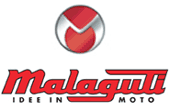
Malaguti is an Italian bicycle, scooter and motorcycle company based in San Lazzaro di Savena, founded by Antonino Malaguti in 1930. Producing bicycles until 1958, they then entered the motorcycle market. Noted for their use of small engines in their bikes. In October 2011, Malaguti laid off its remaining employees in Bologna, Italy as the company eventually folded.

Matchless is one of the oldest marques of British motorcycles, manufactured in Plumstead, London, between 1899 and 1966. A wide range of models were produced under the Matchless name, ranging from small two-strokes to 750 cc four-stroke twins. Matchless had a long history of racing success; a Matchless ridden by Charlie Collier won the first single-cylinder race in the first Isle of Man TT in 1907.

A motorcycle engine is an engine that powers a motorcycle. Motorcycle engines are typically two-stroke or four-stroke internal combustion engines, but other engine types, such as Wankels and electric motors, have been used.

Husaberg was a manufacturer of enduro motorcycles with four and two-stroke engines, the displacements ranging from 125 cc to 650 cc. Originally based in Sweden, its motorcycles were later manufactured in Austria by parent company KTM until the line was retired in 2014.

Česká zbrojovka a.s. is a Czech company producing forklifts Desta and components for the automobile industry, it is former firearms manufacturer, also known for making ČZ motorcycles. ČZ was established as a branch of the Škoda Works Armament in Strakonice, Czechoslovakia in September 1919.

The Ducati singles were single cylinder motorcycles, made by Ducati from 1950 to 1974. Chief Engineer Fabio Taglioni developed a desmodromic valve system in these years, a system that opens and closes the valves using the camshaft, without the need for valve springs. This valve system has become a trademark feature of Ducati motorcycles.
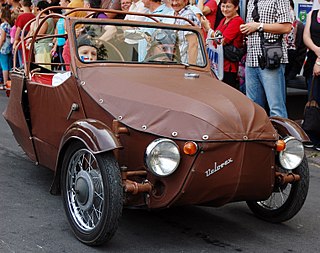
Velorex was a manufacturing cooperative in Solnice, Czechoslovakia. Notable products included a small three-wheeled car, produced from the 1950s until 1971, and the Type 562 sidecar. The sidecar is still manufactured in the Czech Republic by Velorexport, the successor to Velorex.

Bianchi was a brand of Italian motorcycle made from 1897 to 1967 by F.I.V. Edoardo Bianchi S.p.A. The company also produced automobiles from 1900 to 1939, and today is a major Italian bicycle manufacturer. Edoardo Bianchi started his bicycle manufacturing business in a small shop on Milan's Via Nirone in 1885. Bianchi was a prominent name in the motorcycle racing world from 1925 to 1930.

Ideal Jawa (India) Ltd was an Indian motorcycle company based in Mysore, which sold licensed Jawa motorcycles beginning in 1960 under the brand name Jawa and from 1973 as Yezdi. The catchphrase for the bikes sold by the firm was "'Forever Bike, Forever Value". Jawa motorcycles were introduced in India in 1960 and they have a cult following to this present day. Production was carried out directly in India by Ideal Jawa India Ltd based out of Mysore. The Yezdi factory was located at Yadavagiri along the railway line which heads to Mysore Junction. The factory was inaugurated by the then Governor of Mysore State, Sri Jayachamaraja Wadiyar, Maharaja of Mysore in 1961.
The Yezdi Roadking was a motorcycle produced in India by Ideal Jawa Ltd, Mysore from 1978 to 1996. It was based on the CZ 250 motocross ridden by Jaroslav Falta to the runner-up spot in the 1974 motocross world championship. It was sold under the brand name Yezdi. The bike won several Indian rallies and road races. The bike had a 250 cc engine with dual exhausts and a semi-automatic clutch and Jawa/CZ's trademark integrated gear shifter/kick-starter.

The Royal Enfield Bullet was an overhead valve, single-cylinder, four-stroke motorcycle initially made by Royal Enfield in Redditch, Worcestershire England. It was later produced by Royal Enfield (India) at Chennai, Tamil Nadu, India, a company originally founded by Madras Motors to build Royal Enfield motorcycles under licence in India. The Royal Enfield Bullet has the longest and unchanged production run of any motorcycle having remained continuously in production since 1948. The Bullet marque is even older and has passed 75 years of continuous production. The Royal Enfield and Bullet names were derived from the British company which had been a subcontractor to the Royal Small Arms Factory in Enfield, London.

Balkan was a brand of motorcycles, mopeds and bicycles manufactured in Lovech, Bulgaria in 1957-1975.
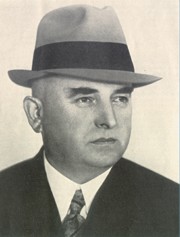
František Janeček (1878–1941) was the founder of Jawa motorcycles and an important figure in the development of the Czech motorcycle industry. He died on 4 June 1941.
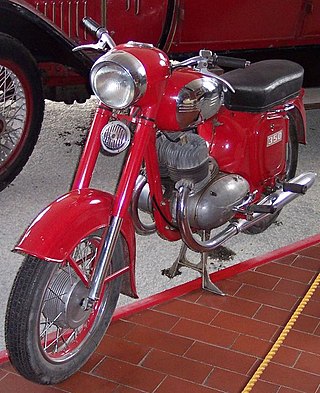
The Jawa 350 is a motorcycle, produced by Jawa Moto in Czechoslovakia since the 1930s until 1992 and in the Czech Republic until present. In the 1950s, with its two-stroke, air-cooled 343 cc engine it could reach speeds of 132 kilometres per hour (82 mph) and was exported into over 120 countries of the world.

Meguro motorcycles were built by Meguro Manufacturing Co motorcycle works (目黒製作所), founded by Nobuji Murata and a high-ranking naval officer, Takaji Suzuki, in 1937. One of the first Japanese motorcycle companies, it became a partner of Kawasaki Heavy Industries Ltd, and was eventually absorbed. Named after a district of Tokyo, Meguro had its roots in Murato Iron Works, which was established in 1924. Meguro Seisakusho, which had once developed a copy of a Harley-Davidson V-twin, was established to design and build gearboxes for the nascent Japanese motorcycle industry. Abe Industries, which had once produced its own motorcycle, merged with Meguro in 1931. The brand is being revived by Kawasaki with a new K3 model to be introduced in Japan on February 1, 2021.

BSA motorcycles were made by the Birmingham Small Arms Company Limited (BSA), which was a major British industrial combine, a group of businesses manufacturing military and sporting firearms; bicycles; motorcycles; cars; buses and bodies; steel; iron castings; hand, power, and machine tools; coal cleaning and handling plants; sintered metals; and hard chrome process.
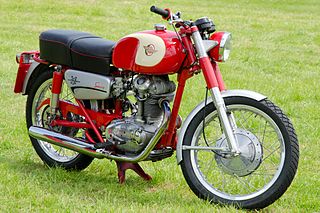
The Ducati Sebring is a 340 cc (21 cu in) single cylinder bevel drive SOHC motorcycle produced by the Italian manufacturer Ducati from 1965 to 1968. At the time of its introduction it was the largest capacity Ducati machine. Production of the original model ended in 1967 when the 'wide case' Mark 3 was introduced, although just over 200 Sebrings were made in 1968 with the 'wide case' engine. Total production was around 3,500 machines.

The Ducati 350 Mark 3 is a 340 cc (21 cu in) single cylinder bevel drive SOHC motorcycle produced by the Italian manufacturer Ducati from 1968 to 1974. It was one of the first 'wide case' Ducati singles produced. A higher performance version, the Ducati 350 Mark 3D, which used desmodromic valves was also available.



































